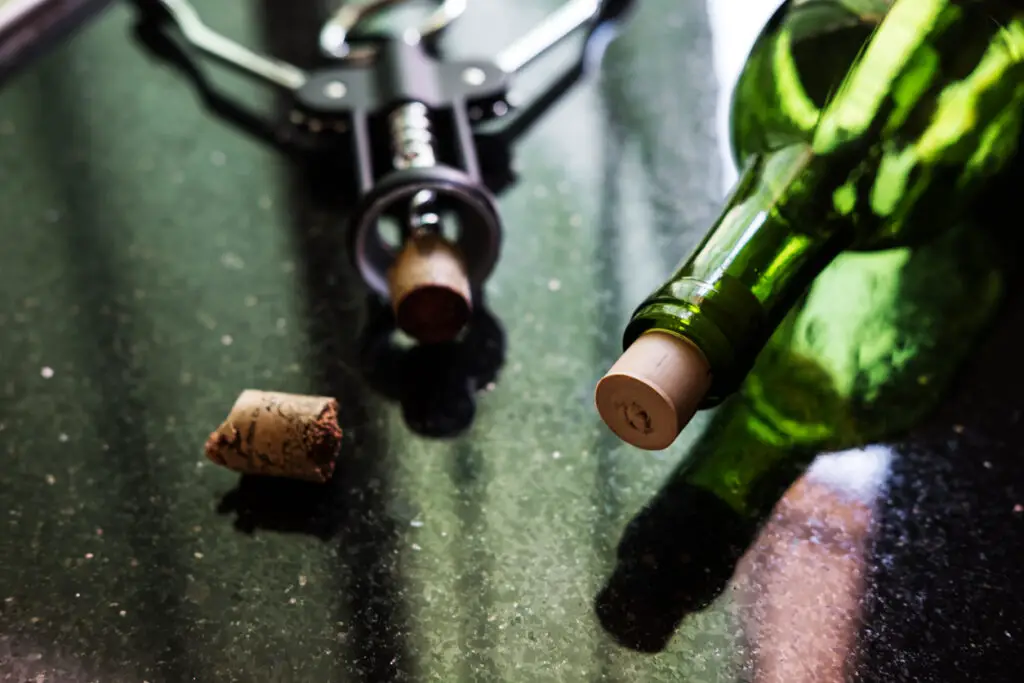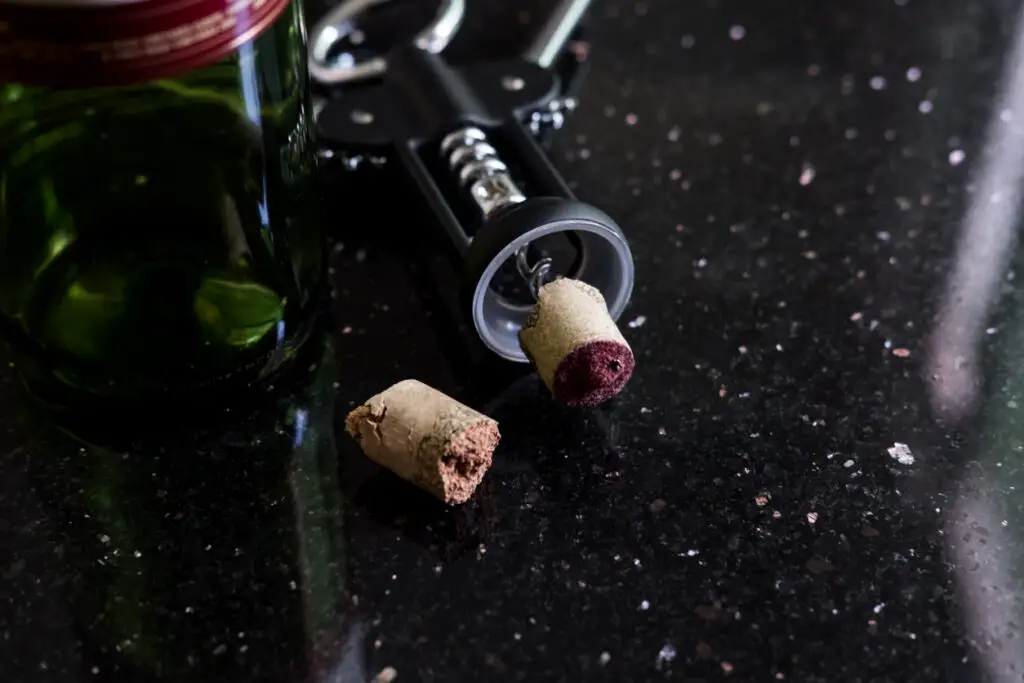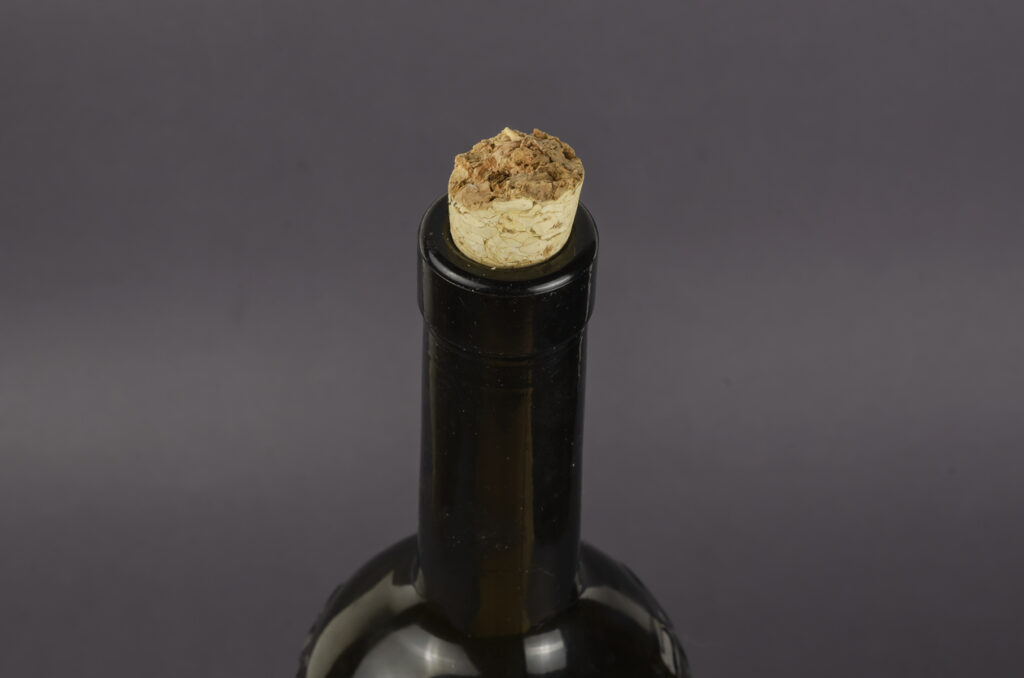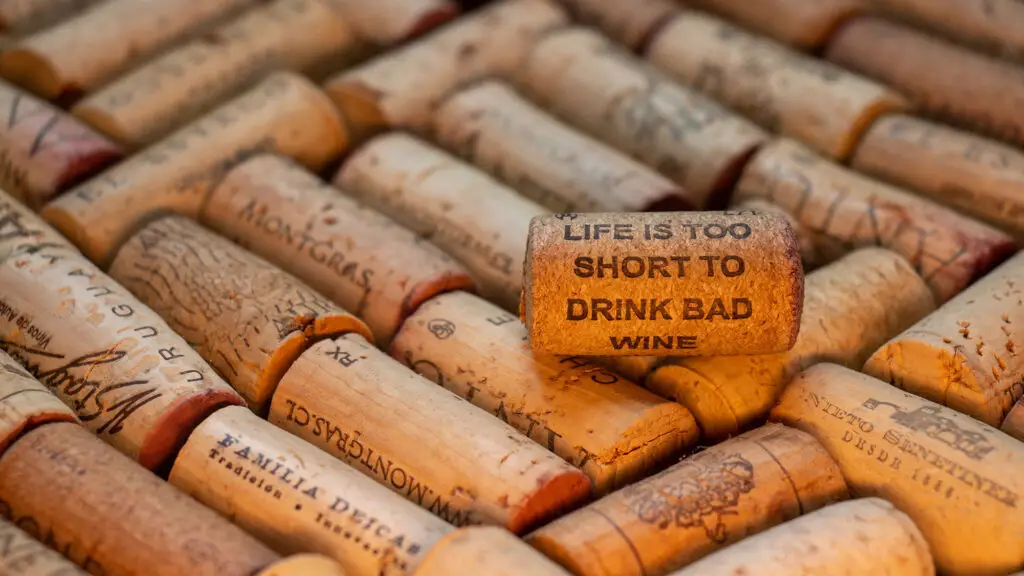Who doesn’t enjoy a bottle of wine at a dinner party? But, imagine you are opening a bottle you saved for a special evening when all of a sudden the cork crumbles. Then, you peek inside only to see chunks floating around, ruining the wine you were waiting to try. Now, the million-dollar question is, can you drink wine if the cork crumbles?
The short answer is yes! You can still drink the wine if the cork crumbles. We recommend pouring the wine through a sieve to filter out the chunks of cork then enjoying your wine normally. But there are multiple ways to salvage a wine bottle after the cork has crumbled.
Of course, most people would immediately push the whole cork in, but that is just going to lead to more flakes in the drink. Instead, we recommend carefully turning up the corkscrew you were using to open the wine without pushing it down too much. Work it back up to attempt a removal of the cork.
If you own a two-pronged cork puller, then this is also an excellent tool to use in this situation. Once you have removed the cork, the key is to strain the wine to remove anything left in the liquid.
Now, let’s dive deeper to understand just why cork crumbles and how to avoid it happening in the future.
Why Does Cork Crumble?

Answering the question “can you drink wine if the cork crumbles” is a solution to a problem that could have easily been non-existent.
Whenever you see a rack or cabinet for wines at a furniture store or in a cellar, they are always slotted in place horizontally. Now, if you are wondering why then your answer is right here. These slots are not only for aesthetic reasons but also for practical reasons. Storing your wine horizontally constantly keeps the cork wet.
Author Note: When you leave a bottle of wine upright, the wine tends to settle a little below the cork. With time, the cork will remain dry and become brittle. Then, small flakes of cork will crumble off and float around in your wine. This will usually happen when the corkscrew you use to open the bottle dislodges the dry pieces.
When your bottle is lying down, the wine is constantly in contact with the cork, and this makes it moist and soft.
But, the wetness is not the only reason a cork crumbles. Another factor is the age of the wine. Cork becomes more prone to breakage the older it becomes. So, older cork is very likely to break when the bottle is being opened. The tool you use to open is also important. Corkscrews with a sharp end instead of a smooth one will most likely break the cork as well.
Can You Drink Wine If the Cork Crumbles?
We already discussed this question at the beginning of our article, but let’s dive a little deeper. Cork will crumble at the bottom part, meaning you won’t have access to the wine until you get rid of it all. It may be tempting to push all the cork in, but this isn’t recommended.
More flakes will surely start to fall off into the wine, which will ruin it. Instead, gently turn the corkscrew you were using up to work the cork back.
But, do not put too much pressure onto it; otherwise, you will be forcing it to crumble further. As we mentioned, a two-pronged cork puller can also be used to slot between the cork and the glass, then pull out the cork completely. This puller won’t create a hole in the cork, so you will be avoiding any further damage.
Once the bottle is opened, it is vital to strain the wine to get rid of any cork fragments. The best method of doing this is to pour the wine into a cheesecloth, coffee filter, or any other porous material. Really anything that will let the wine flow through but stop the cork will do. Now, we do not recommend using a sieve since the holes on these are usually large.
The small cork fragments will surely flow through and end up in someone’s glass! So, now you know the answer next time anyone asks, “can you drink wine if the cork crumbles?”.
How Can I Fix Dried Out Cork?

Now you know the answer to can you drink wine if the cork crumbles already, but is there any way to prevent the crumbling of cork that you already know is dry. Maybe you forgot to lay your wine out horizontally, and now you are dreading opening that bottle.
But, don’t fret as we have a few solutions for you. Once you fix the cork, you will avoid having to ruin the wine or going through the process of removing and straining the cork.
Author Note: The first way you can try to re-moisturize your cork is by setting the wine horizontally for 24 hours. Hopefully, the cork will be able to absorb some of the wine, and you will have stopped the crumbling.
Another easy method is to boil a small amount of water and soak a cloth in it. Then use tongs to remove the washcloth from the water, place it in your hand (with an oven mitt on) and slowly place it over the cork. Try to gently twist the cork out of the bottle.
The hot water should moisten and loosen the cork. If you have a cork puller with two prongs, then this is the time to use them.
Try to rock the cork back and forth to remove it. Once you have rehydrated and removed the cork, we recommend you drink the wine right away. This is because the moisture may encourage microorganism growth, which will ruin your wine.
We want to remind you to always store your wine on its side, and preferably in a humid environment. The ideal environment for wine storage is between 50 and 55 degrees F and 70 percent humidity.
How Do I Stop a Cork from Crumbling?
The unfortunate truth is that corks of older wines are very prone to crumbling, so the question becomes how can you stop a cork for crumbling?
Keeping the cork intact comes down to the proper storage and maintenance of your wine. The second set of tips comes when you are actually opening said wine.
When it comes to the storage, house the wine in a cool, dark place with little to no fluctuations of temperature. If you have a wine fridge that’s even better. Next, ensure it’s placed horizontally to keep the cork wet. As soon as the cork is allowed to get dry it can become brittle and ultimately crumble upon opening.
When opening an older bottle that you’re nervous about use the thinnest and sharpest blade possible. Open it in advance to actually drinking it and open it as slowly as you possibly can. This will allow the pressure to be released from the wine slowly, avoiding sudden cork movements that could break it or lead it to crumble.
What Is Cork Made of and Why Is It in My Bottle?
Okay, so we covered the cork crumbling emergency, but why is cork used in wine anyway? Well, let’s find out!
Unless you are a fan of boxed wine, cork has played a significant role in your wine journey. But cork is more than just the barrier between you and your alcohol. It’s a critical part of winemaking history and is inseparable from the wine. Although there are many new advances in the technology of wine culture, screw-on caps will hardly replace the role of cork.
Although harvesting cork has been a practice since ancient Greece, it wasn’t used to close glass wine bottles until recently. Just like wine, cork is also from a living organism: the Quercus suber, or cork oak. Although the life cycle of the wine industry is a rushed frenzy, these evergreen oaks grow like sloths, slowly producing what is known as orange cork.
Having an average lifespan of around 200 years, each tree provides thousands of bottle stoppers if treated well.
How Corks are Made
The short version of the long cork life cycle is like this: Good cork trees grow to 25 years old in semi-arid forests along with other animals and plants on the Iberian peninsula and North Africa. Then, experienced harvesters of cork use axes to cut off the outer tree bark while leaving its inner wood section undamaged.
These planks of cork bark are then dried, sorted, and processed.
To make the cork like how we know it, these slices are boiled to remove any impurities such as cork taint causing chemicals. Then, they are dried until they achieve the optimum texture to be pressed for bottles. It takes around nine years for the outer bark to regenerate before the next harvesting cycle starts.
Of course, only high-quality cork bark is used to make bottle stoppers, while the lower-quality bark is repurposed. This makes the industry environmentally! Lower-quality or crumbled cork material will usually be used to make composite corks, shoes, flooring, and much more.
And studies have shown that these cork trees are not running out, and they are also protected by the local governments, so your wine isn’t going anywhere!
Is Plastic Really Fantastic?

Now, we all know that natural forest bark cork isn’t the only option for bottling wines. Synthetic corks have been all the rage recently. What makes them so good? Well, for one, they have no taint, which already puts them at an advantage to natural cork.
They are made from polyethylene, which is also used to make milk bottles and plastic pipes.
Author Note: These corks are designed to act similarly to natural cork, but they let in more oxygen and are consistent in oxygen transmission. This consistency is great for winemakers since they can be sure that the wine will have a predictable taste at specific points in time.
With these corks, winemakers can also tweak the oxidation amount of their wine by choosing a specific plastic cork with a known oxygen transmission.
Of course, most people still prefer the traditional cork over the plastic ones. Even though the plastic ones are a more modern invention, real cork is still a sign of luxury, and most well-known wine companies still use real cork. So, it really is up to you what you choose!
Wrapping Up
Well, now it’s time to put a cork on this article! Hopefully, you will remember the answer to important questions such as why is cork used in wine, and can you drink the wine if the cork crumbles. If you take one lesson away from our article, it is that you should always store your wine lying down.
And, even if you forget to, there is always a solution.
Now, go enjoy that bottle of wine you have been saving!
To living a full-bodied life,
Wesley

